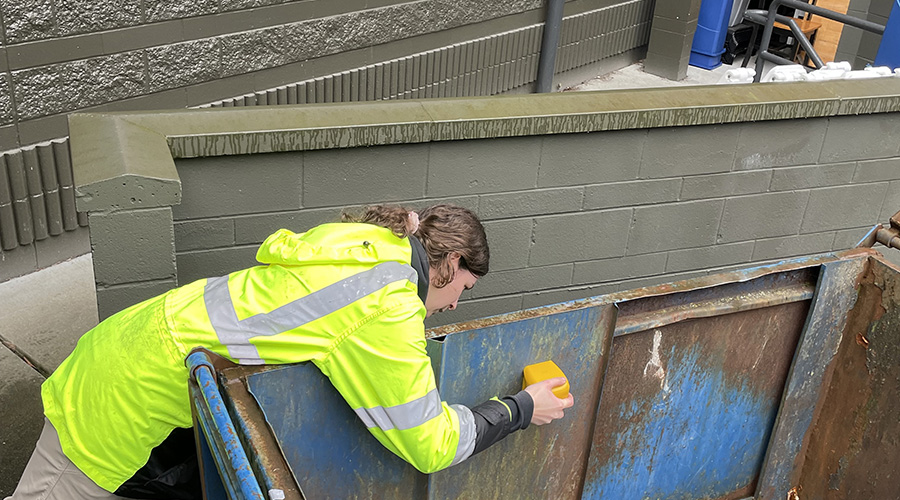Green 2.0: Hospitals and the Enviroment
Tapping into new-generation technology, Colorado hospital shows the way in minimizing facilities’ environmental impact
Over the past several years, the demand for green products has produced a wave of advances in building technologies. How will the next generation of green technologies affect health care facilities? Many products might raise the bar for energy efficiency and water conservation, while others might help organizations reduce waste and make indoor environments healthier.
“There are so many products and so many more being introduced all the time,” says Joe Howard, director of facilities at Boulder (Colo.) Community Hospital (BCH), which consists of four facilities.
Howard should know about the impact of green products. In 2003, Boulder Community Foothills Hospital became the first hospital in the nation to earn the U.S. Green Building Council’s Leadership in Energy and Environmental Design certification. Since then, manufacturers have unveiled myriad technologies designed to be environmentally responsible, fiscally sound alternatives.
The hospital’s deliberations and decisions might offer a road map for other institutional and commercial organizations looking for both financial and environmental benefits.
Alternative Energy
While minimizing energy-related costs is a top priority for managers, power reliability and environmental friendliness are as high on the list. Because the burning of fossil fuels releases toxins, many organizations are taking a closer look at alternative energy.
About 2 percent of the energy BCH uses at its Broadway Hospital is generated by wind power provided by its utility. BCH pays more for wind-generated power than fossil-fuel power.
“From our viewpoint, if it’s a more environmentally friendly way to produce power, we’re willing to pay a modest premium for it because we think there are long-term ecological benefits,” he says, adding that lower energy costs might become another benefit.
“The cost of wind-generated power is staying the same, while the cost of other power sources are increasing,” he says. While wind-generated power now costs about 10 percent more per kilowatt-hour than fossil-fuel power, he wouldn’t be surprised if the cost of fossil-based fuels soon surpasses that of wind power.
Howard also is considering photovoltaic solar panels as another energy source. He has been talking with several suppliers who can install panels on all of BHC’s roofs. During these discussions, Howard also is aware of the systems’ potential drawbacks.
“Our biggest concern is the long-term maintenance of the roofs,” he says. “We recognize that any time you keep sunlight off a roof — by bouncing it off something or absorbing it in a solar panel — that has a positive effect on the roof’s life,” he says. “But we know at some point in time we are going to have to make repairs to the roofs.” As a result, Howard is most interested in systems featuring panels that technicians can remove and replace easily to make roof repairs.
Another concern is ensuring the panels can withstand high-velocity winds.
“We get 90-100 mile-per-hour winds here several times a year,” he says. So, he is paying particular attention to methods of panel installation and ways to reduce the risk of panels blowing off the roof. If the project goes well, Howard hopes the panels will reduce BCH’s total power use from the utility’s power grid by about 5 percent.
Cooling-tower Technology
In addition to minimizing energy costs, the use of more efficient technologies can help reduce the emission of toxins. Howard says recent advances in cooling-tower technology have proved effective in reducing BCH’s energy use. Compared to traditional cooling towers, the new technology sprays a fine water mist on a larger surface area and moves air more effectively, making the system more efficient in cooling water.
“The larger the evaporative surface area, the faster the water cools,” Howard says.
The new cooling-tower technology can increase the surface area by spraying water and moving air into the tower’s corners. Traditional cooling-tower systems spray water in a circular pattern. As a result, water doesn’t reach the tower’s corners. These systems also tend to feature large-diameter fans that don’t efficiently move air.
The new system features a rotary head that sprays water in a square pattern that reaches the corners. It also has eight small fans on the bottom of the tower — as opposed to one large fan on top — that circulate air more efficiently. Howard implemented the new technology in at BHC’s Broadway facility two years ago.
“Since installing the new systems, our tower-operation costs have dropped significantly,” he says. Even when they were new, the old towers were less efficient than the new ones, and they often could not keep up with the facility’s load requirements. In addition to performing more efficiently, the new system requires less horsepower (hp). The fans on the new system require a maximum of 45 hp, while the old fans required 75 hp.
Chemical-free Water
To eliminate the cost of chemicals, as well as reduce the amount of chemicals BCH disposes of in the waste stream, Howard is considering chemical-free water-treatment technology for the facilities’ boilers and chillers.
As water cycles through the system under consideration, electromagnetic energy injures the bacteria, making them incapable of multiplying. The bacteria are exposed to the energy multiple times as the water recycles through the system.
The system also causes the existing scale in the pipes to break up and precipitate out. But in some cases, scale actually might be the only thing holding older pipes together, Howard says.
“The system might clean up the scale so well that you find that your pipe is virtually gone,” he says.
For this reason, BCH won’t install the chemical-free water-treatment system in its Broadway facility, which has 60-70-year-old pipes, says Joel Brown, BCH’s facility manager.
“Since the system will remove existing scale, we’re concerned that if we put the system in before we upgrade our piping, our pipes might leak,” Howard says.
Adds Brown, “If we descale the pipes at that campus, they are going to turn into a sieve.” Howard says this problem doesn’t seem to occur in facilities with strong pipes. He spoke with maintenance managers at another hospital who installed the chemical-free system at their facility.
“The reading that I got is that it was working terrific,” he says. “They had to clean the filters in their condenser system pretty frequently for a while because it was cleaning so much old crud out of the system.”
Adds Brown, “We will probably install the system in our Foothills Hospital, which is our newest building, next year.”
Specification Strategies
Obtaining funds for green technology at BCH is relatively easy because it has a culture that supports environmental friendliness, Howard says. Still, he sometimes had to convince executives that implementing specific technologies can benefit the organization.
“When I started working here, one of my biggest challenges was establishing credibility,” he says. “We’re over that hump now, We’re building on our successes, and getting funding for our future ideas is a lot easier.”
Howard attributes those successes to careful research. Long-term difficulties can occur when managers — particularly those new to an organization — are eager to implement an emerging technology but don’t research it thoroughly.
“If they purchase the equipment and it didn’t do what was expected, obtaining funding for future projects can be much more difficult,” Howard says. Instead, he says, managers might consider implement proven technologies they know will be successful before experimenting with lesser-known products.
“Stick to projects you know will work, establish credibility, and do the things you’ll say you’ll do,” he says. “Then you can talk about things that are more leading edge.”
When considering products that feature newer technologies, Howard seeks advice from other organizations that already have implemented the product. Also, sales representatives can provide a list of references in organizations that have used a product.
“When we’re researching a new technology, we don’t just call the people the sales representative tells us to call,” Howard says. He also contacts organizations on the project list for which the representative didn’t provide contact information.
Most importantly, it is critical to talk with people who maintain the equipment.
“The (sales representative) might give us contact information for someone in a chief financial officer position,” he says. “If the project was within budget and on time, chances are that person was probably happy with the project.”
Howard prefers to talk with managers and technicians in maintenance and engineering departments, as well as individuals who regularly use the equipment.
“If, for example, we were remodeling a lab, we would call the lab directors and talk to them,” he says. For the best advice, managers also can contact their long-time peers at other organizations.
“If they installed systems I’m interested in learning more about, I’ll call them because I know I can trust their advice,” he says.
With so many new green technologies on the market, determining the most appropriate options can be a time-consuming task but one that more often is worth the effort.
“It’s a matter of diligence,” Howard says. If managers want to make green technology a top priority, it is essential for them to keep their eyes open for the right opportunities and make green part of their organization’s selection criteria.
Related Topics:











